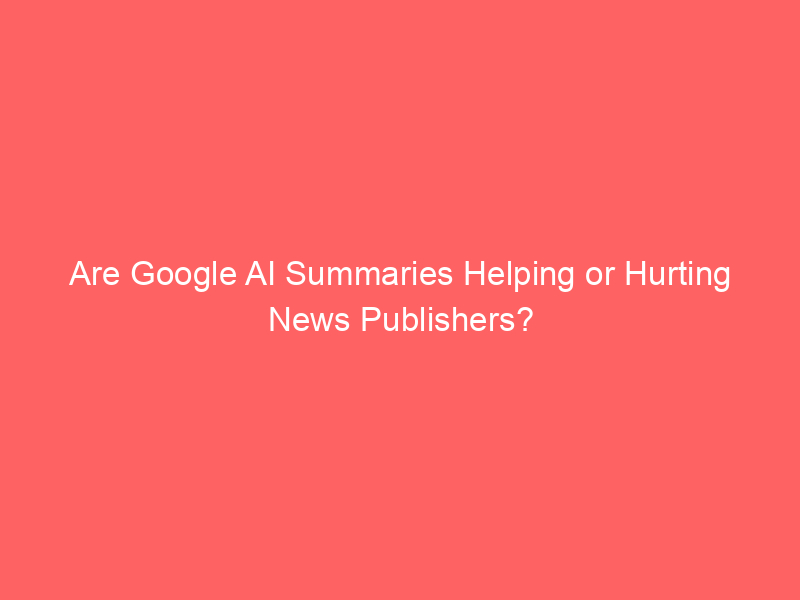In the rapidly evolving landscape of digital news, new technologies continually reshape how content is consumed and distributed. Among these innovations, Google’s AI summaries stand out as a tool that can significantly alter the way news reaches audiences. While some see this as a promising advancement for efficiency and accessibility, others worry it might threaten traditional revenue streams and the quality of journalism. As AI-generated summaries become more prevalent, it’s essential to understand whether they serve as a boost or a burden for news publishers.
How Google AI Summaries Impact News Publisher Revenue
Google AI summaries are designed to provide quick, concise overviews of longer articles, making information more accessible to users who prefer a brief glance rather than a full read. On one hand, these summaries can increase engagement by attracting readers who might not have the time to dive into full articles, potentially driving more traffic to news websites. This increased visibility can translate into higher ad impressions and click-through rates, offering publishers an additional revenue stream. Moreover, AI summaries can help news outlets reach a broader audience, including those with disabilities or limited internet bandwidth, which might otherwise limit access to content.
However, there’s a downside: as AI summaries often appear directly in search results or snippets, they can reduce the need to visit the original publisher’s website. If users find the summary sufficient, they may skip the full article altogether, leading to a decline in page views. This phenomenon, known as "traffic cannibalization," can hurt publishers’ ad revenue, especially if AI summaries become the dominant form of content consumption. Additionally, publishers risk losing control over how their content is presented and monetized when it is summarized or repurposed by AI, potentially undermining their revenue models.
Furthermore, the reliance on AI summaries raises questions about content licensing and copyright. If AI tools generate summaries without compensating publishers for their original work, it could lead to revenue losses and ethical concerns. Some publishers worry that AI summarization might devalue their journalism, making it easier for competitors or aggregators to provide quick snippets without supporting original reporting. As AI continues to evolve, the impact on revenue streams will largely depend on how publishers adapt and whether they can leverage these tools to complement their existing strategies.
Are News Outlets Gaining or Losing with AI-Generated Content
The debate over AI-generated content is complex, with valid points on both sides. On the positive side, AI summaries can serve as a gateway for less engaged readers, encouraging more frequent interaction with news outlets. When used effectively, publishers can harness AI to enhance user experience, funnel traffic to their sites, and strengthen brand loyalty. Some media companies are experimenting with AI to personalize content, tailoring summaries to individual preferences, which can lead to increased user satisfaction and retention. In this way, AI can be a tool that helps outlets expand their reach and deepen their relationship with audiences.
Conversely, the risk for news outlets is that AI summaries may erode traditional revenue models if they diminish the need for users to visit full articles. As AI takes on a larger role in content dissemination, publishers might see a decline in direct traffic, reducing opportunities for ad sales and subscription conversions. This shift could also impact the quality of journalism, as outlets might prioritize producing summaries optimized for AI algorithms over original, in-depth reporting. In the long run, over-reliance on AI summaries could undermine the credibility and depth that distinguish reputable news organizations from aggregators and content farms.
Ultimately, whether news outlets are gaining or losing depends heavily on their strategic response to AI summaries. Publishers that view AI as a complementary tool rather than a replacement are more likely to benefit. By integrating AI summaries into a broader content strategy—adding value through exclusive stories, multimedia content, and subscription models—they can mitigate potential losses. The key will be to strike a balance, leveraging AI to enhance, not replace, high-quality journalism, and to maintain a sustainable revenue model in an increasingly automated information landscape.
Google AI summaries undoubtedly bring both opportunities and challenges for news publishers. While they offer new avenues to reach audiences quickly and efficiently, they also pose significant threats to traditional revenue streams and the depth of journalism. The future of this technology’s impact hinges on how publishers adapt—embracing AI as a tool that complements their core mission rather than diminishes it. Ultimately, the most successful outlets will be those that find a way to harness AI to enhance their storytelling, engage their audience, and uphold the integrity of quality journalism in a rapidly changing digital world.








